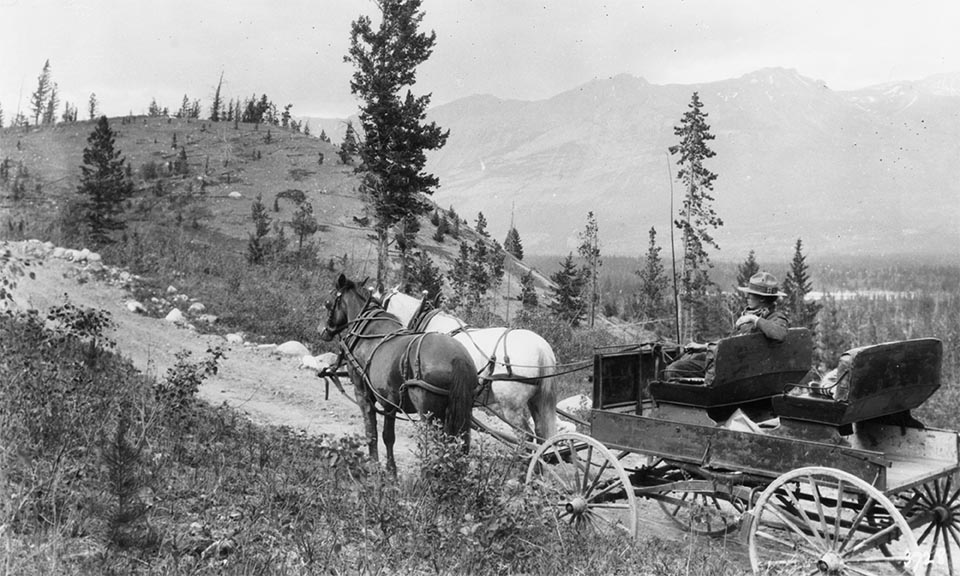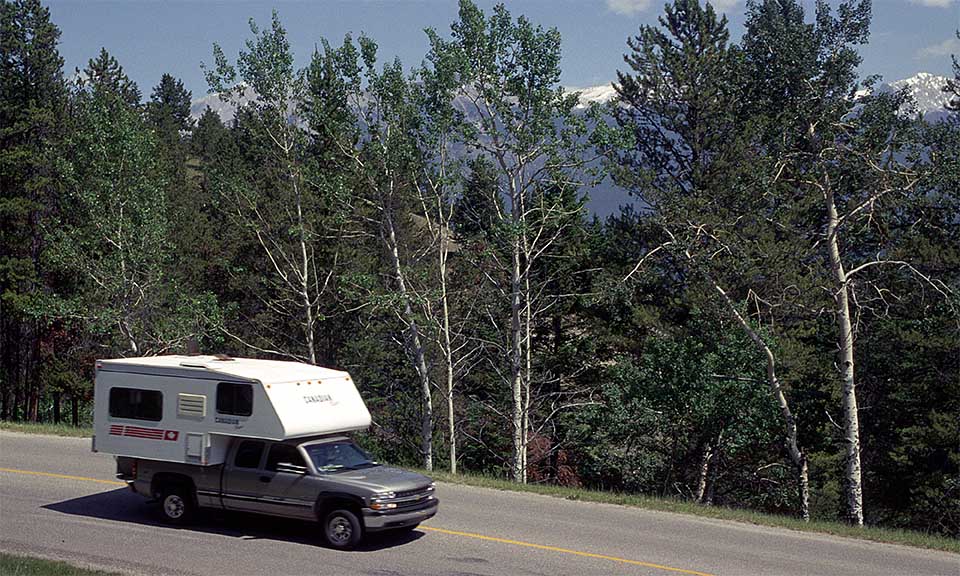Pyramid Lake Road, Jasper National Park in 1914 (W. J. Topley Studio, Library Archives Canada, PA 11068) and in July, 1999 (CW 1999-07A-17).
Fire History Research in the Athabasca Valley near Jasper
Forest fire researcher Gerald Tande used fire-scarred tree growth-rings to develop an amazing chronology of fires for the last four hundred years in the Athabasca Valley near Jasper. Along this section of the Pyramid Lake Road he produced a history that speaks to the frequency and intensity of fires, dating them to 1678, 1714, 1727, 1758*, 1780, 1797, 1807, 1834, 1837, 1847*, 1858, 1861, 1869, 1878, 1889*, and 1905. The dates identified with an asterisk were large fires that swept across most of the valley, probably high-intensity burns that occurred during hot, dry summers. The other fires covered much smaller areas and likely occurred in the spring with lower flame lengths. Tande’s maps of individual fire years (click this link) show this pattern of small and large fires clearly 1.
The 1914 view shows the pattern of vegetation resulting from this mixture of frequent low-intensity fires interspersed with periodic hot burns. A few large, thick-barked Douglas fir, veterans of many fires, dot the landscape. Lodgepole pine and trembling aspen remain in shrubby form due to frequent burns. Since the last fire in 1905 a dense forest has grown here, but if a future wildfire occurs in the summer, likely all trees will be killed due to the abundant fuels. This magnitude of forest change has occurred across much of the broad Athabasca valley in Jasper National Park 2 Eventually, increased forest density and tree ages will trigger large scale tree mortality from forest and insect diseases, increased biomass build-up on the forest floor, and conditions favorable for a large-area, high intensity wildfire. 3
Changing Climate, Changing Culture, and Declining Fire Frequency
Why were fires once so frequent in the Athabasca valley? Why has their frequency declined so sharply? These questions have stimulated much scientific research over the last few decades. One hypothesis is that climate change in the late 1800s resulted in an ongoing, sustained period of relatively wet conditions not favorable for fire ignition or spread. 4
Alternately, some researchers recognize that lightning fires are relatively rare on the eastern slopes of the Canadian Rockies and that First Nations have long-burned the valleys to maintain wildlife habitats and gathering plants.5 If this is so, cultural change around 1900 could be very important. During this period the Canadian government removed First Nations from Jasper and other parks, and implemented fire prevention regulations and fire suppression programs.6
Recently, forest ecologists Raphaël Chavardès and Lori Daniels from the University of British Columbia, and Theresa Dingh and Ze’ev Gedalof from University of Guelph used Tande’s fire history study as a basis to do further detailed field work to cross-date tree ages and fire-scar dates. They tested whether historic fire occurrence depended on inter-annual to multi-decadal variation in climate. Similar to Tande’s work, they dated 18 fires between 1646 and 1915, and some smaller fires after this time. The larger fires likely burned during drought years (based upon tree ring-widths), but these years were only weakly associated to El Niño phases and the negative phase of the Pacific Decadal Oscillation. However, fire frequency varied through time, consistent with climate drivers and changes in land use at continental to inter-hemispheric scales. Most importantly, on most their sample sites few fires have occurred since 1915, although trees susceptible to fire-scarring were present at all sites and climate was conducive to fire over multiple years to decades. Moreover, prior to 1915, most fires appear to have been lit by people in the dormant and earlywood sections of tree rings, outside the lightning season. However, after 1915, fire timing shifted to the latewood, suggesting lightning or mid-summer wildfires. On this basis, the researchers conclude that shifts in human cultural practices, not climate change are most important in Jasper’s declining fire frequency.7.
These results provide support for similar analyses of a long-term weather database for Banff townsite, starting in the 1880s, and used to calculated monthly precipitation and daily fire weather indices. This research suggests that changing human fire management practices, not weather change, best explains declining fire activity.8
Footnotes and Map
- Tande, G. F. “Fire History and Vegetation Pattern of Coniferous Forests in Jasper National Park, Alberta.” Canadian Journal of Botany 57 (1979): 1912–1931 ↩
- Rhemtulla, J. M., R. J. Hall, E. S. Higgs, and S. E. Macdonald. “Eighty Years of Change: Vegetation in the Montane Ecoregion of Jasper National Park, Alberta, Canada.” Canadian Journal of Forest Research 32 (1999): 2010–2021; Chavardès, R. D., and L. D. Daniels. “Altered Mixed-severity Fire Regime has Homogenized
Montane Forests of Jasper National Park.” International Journal of Wildland Fire 25-4 (2016), 433–444.
- White, C. A. “Fire and Biomass in Banff National Park Closed Forests.” Master’s thesis, Colorado State University, 1985; White, C. A., I. R. Pengelly, D. Zell, and M. P. Rogeau. “Restoring Heterogeneous Fire Regimes in Banff National Park.” In Mixed Severity Fire Regimes: Ecology and Management, edited by L. Taylor, J. Zelnik, S. Cadwallader, and B. Hughes, 255–66. Association of Fire Ecology. Pullman: Washington State University Extension, 2005. ↩
- Johnson, E. A., and C. P. S. Larsen. “Climatically Induced Change in Fire Frequency in the Southern Canadian Rockies.” Ecology 72 (1991): 194–201. ↩
- Wierzchowski, J., M. Heathcott, and M.D. Flannigan. “Lightning and Lightning Fire, Central Cordillera, Canada.” International Journal of Wildland Fire 11 (2002): 41–51; Lewis, H. T. “Indian Fires of Spring.” Natural History 89 (1980): 76–83; Lewis, H.T. and T.A. Ferguson. 1988. “Yards, Corridors and Mosaics: How to Burn a Boreal Forest.” Human Ecology 16 (1988): 57-77; White, C. A., M. C. Feller, and P. Vera. “New Approaches for Testing Fire History Hypotheses.” Proceedings of the International Conference on Science and Management of Protected Areas 4 (2001): 398–411. ↩
- MacLaren, I. “Cultured Wilderness in Jasper National Park.” Journal of Canadian Studies 34 (1999): 7–28; Binnema, T., and M. Niemi. “‘Let the Line be Drawn Now:’ Wilderness, Conservation, and the Exclusion of Aboriginal People from Banff National Park in Canada.” Environmental History 11 (2006): 724–50. ↩
- Chavardès, R. D., and L. D. Daniels, Z. Gedalof, D. W. Andison. “Human Influences Superseded Climate to Disrupt the 20th Century Fire Regime in Jasper National Park, Canada.” Dendrochronologia 48 (2018) 10–19; Dingh, T. “Influence of Humans and Climatic Variability on Historic Wildfire Dynamics in Jasper National Park, Alberta, Canada.” Guelph, ON: University of Guelph. M.Sc. Thesis ↩
- White, C. A. Wildland Fires in Banff National Park, 1880–1980. National Parks Branch. Occasional Paper 3. Ottawa: Parks Canada, 1985; Feunekes, U., and C.E. Van Wagner. A Century of Fire and Weather in Banff National Park. Technical Report. Ottawa, ON: Parks Canada, 1995. ↩

